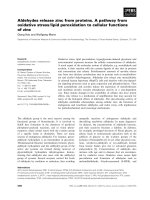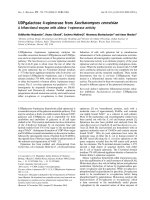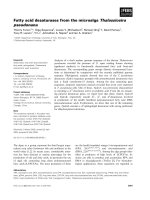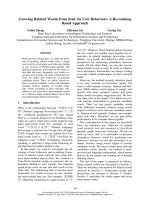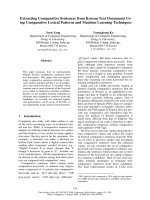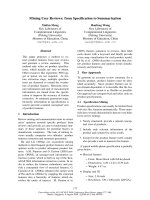Báo cáo khoa học: Small peptides derived from the Lys active fragment of the mung bean trypsin inhibitor are fully active against trypsin pptx
Bạn đang xem bản rút gọn của tài liệu. Xem và tải ngay bản đầy đủ của tài liệu tại đây (574.27 KB, 9 trang )
Small peptides derived from the Lys active fragment of the
mung bean trypsin inhibitor are fully active against trypsin
Rui-Feng Qi
1
, Zhi-Xue Liu
2
, Shao-Qiong Xu
1
, Ling Zhang
1
, Xiao-Xia Shao
1
and Cheng-Wu Chi
1,2
1 Institute of Protein Research, Tongji University, Shanghai, China
2 Institute of Biochemistry and Cell Biology, Chinese Academy of Sciences, Shanghai, China
Introduction
Proteinase inhibitors occur ubiquitously in microor-
ganisms, plants, and animals [1]. In plants, there are a
variety of serine proteinase inhibitors, which are
divided into 16 classes [2]. A Bowman–Birk protease
inhibitor (BBI) was first isolated from soybean by
Bowman [3], and was later characterized by Birk et al.
[4]. BBIs have been found in the Fabaceae [5,6], with
two catalytic sites [7–10]. The specificity of each
reactive site is dependent on the amino acid at the P
1
position. The structural features, molecular evolution
and potential applications of BBIs were reviewed in
our recently published article [11].
BBIs share a homologous sequence, especially in the
reactive site loop, and a conserved seven disulfide
bridge network [12]. Because of the highly stable struc-
ture of disulfide bridges, BBIs can be resistant even to
cooking temperatures, and can survive in the digestive
system of animals [13]. Thus, one important role of
BBIs is thought to be as defensive agents against insect
and microbial pest attack [14,15], and plants with BBI
transgenes can efficiently retard larval growth [16]. In
addition, it was found that BBIs may act as cancer
preventive and suppressing agents; for example, the
soybean BBI concentrate was tested in phase II clinical
Keywords
Bowman–Birk inhibitor (BBI); gene cloning;
gene expression; inhibitory activity; peptide
synthesis
Correspondence
C W. Chi, Shanghai Institute of
Biochemistry and Cell Biology, Chinese
Academy of Sciences, 320 Yue Yang Road,
Shanghai 200031, China
Fax: +86 21 54921011
Tel: +86 21 54921165
E-mail: or
(Received 23 August 2009, revised
20 October 2009, accepted 4 November
2009)
doi:10.1111/j.1742-4658.2009.07476.x
The Bowman–Birk protease inhibitors have recently attracted attention for
their potential as cancer preventive and suppressing agents. They contain
two canonical binding loops, both consisting of nine highly conserved resi-
dues capable of inhibiting corresponding serine proteases. In this study, we
cloned the cDNA of the mung bean trypsin inhibitor, one of the most studied
Bowman–Birk protease inhibitors. A modified peptide, Lys33GP, with 33
residues derived from the long chain of the Lys active fragment of mung
bean trypsin inhibitor, was successfully expressed in Escherichia coli as a
glutathione-S-transferase fusion protein. The recombinant product was
obtained with a high yield, and exhibited potent inhibitory activity. Mean-
while, a shorter peptide composed of only 16 residues (the Lys16 peptide),
corresponding to the active core of the fragment, was synthesized. Both the
recombinant and the synthesized peptides had the same inhibitory activity
toward trypsin at a molar ratio of 1 : 1, implying that the Lys16 peptide with
two disulfide bonds is possibly the essential structural unit for inhibitory
activity. Using site-directed mutagenesis, the P
1
position Lys was replaced by
Phe, and the resulting mutant, Lys33K ⁄F, was determined to have potent
chymotrypsin inhibitory activity. Both Lys33GP and the Lys33K ⁄ F mutant
may be potential pharmaceutical agents for the prevention of oncogenesis.
Abbreviations
Acm, acetamidomethyl; BApNA, N-benzoyl-
DL-arginine-p-nitroanilide; BBI, Bowman–Birk protease inhibitor; BTEE, N-benzoyl-L-tyrosine ethyl
ester; Fmoc, fluorenylmethoxycarbonyl; GST, glutathione-S-transferase; IPTG, isopropyl thio-b-
D-galactoside; MBTI, mung bean trypsin
inhibitor; PSP, PreScission protease; SFTI-1, sunflower trypsin inhibitor-1; SOE-PCR, splicing by overlapping extension PCR; TFA,
trifluoroacetic acid; Trt, trityl.
224 FEBS Journal 277 (2010) 224–232 ª 2009 The Authors Journal compilation ª 2009 FEBS
trials for the treatment of patients with oral leucopla-
kia [17–19]. As tumor formation is related to an
abnormally high protease activity, especially the chy-
motrypsin-like protease activity, it would be desirable
to discover a small peptide drug capable of inhibiting
this enzyme.
In the early 1960s, we purified and crystallized
mung bean trypsin inhibitor (MBTI) and its com-
plexes with one or two molecules of trypsin [20,21].
We also demonstrated that MBTI contains two active
domains [22]. Later, the two active fragments of
MBTI were successfully separated by restricted peptic
digestion [23], and the sequence of MBTI was eluci-
dated [24]. The active fragment with Arg at the reac-
tive site P
1
is composed of 27 residues, whereas the
active fragment with Lys at the reactive site is com-
posed of two peptide chains, a 26-residue long chain
being linked to a nine-residue short chain by two in-
termolecular disulfide bonds. The two peptide chains
of the Lys active fragment could be separated from
each other by reduction, and the long peptide chain
still exhibited inhibitory activity after reoxidation [25].
A 22-residue peptide derived from the long chain, with
three intramolecular disulfide bonds, was synthesized,
giving two disulfide isoforms, both of which remained
active against trypsin, with K
i
values of 1.2 · 10
)7
m
and 4 · 10
)8
m, respectively [26].
In the present article, we describe the cDNA cloning
of MBTI, and the gene expression of a 35-residue
peptide and its mutant both derived from the long chain
of the Lys active fragment of MBTI. The total synthesis
of a 16-residue peptide corresponding to the core of the
active fragment and the inhibitory activity assays of all
expressed and synthetic peptides are also reported.
Results
Gene cloning of MBTI
In the early 1980s, we elucidated the incomplete pro-
tein sequence of MBTI with 72 residues [24]. In the
present work, based on the known amino acid
sequence, we cloned the cDNA of MBTI (GeneBank
accession number AY713305) by using 3¢-RACE and
5¢-RACE (Fig. 1). The 591 bp full-length cDNA
includes a 3¢-UTR and two polyA signals (AATAAA)
located upstream of the polyA tail. The 321 bp ORF
encodes a 107-residue protein that shares high
sequence homology with several BBIs from other
leguminous dicotyledons (Fig. 2). The MBTI gene
(GeneBank accession number AY251011) was then
amplified from total genomic DNA, demonstrating
that there is no intron in the genomic gene sequence.
The deduced MBTI sequence was compared with
the previously determined sequence [24,27] and the
MBTI-F reported by Wilson et al. [28] (PRF accession
number 0907248A) (Fig. 3). The results showed that
the deduced sequence was basically consistent with the
determined sequence, except for six undetermined resi-
dues at the N-terminus and two additional Asp resi-
dues at the C-terminus. These differences can be
explained by the fact that the previous sample used for
sequencing was first treated with aminopeptidase M to
eliminate the heterogeneity of the N-terminal part of
MBTI, so the N-terminal hexapeptide (SSHHHD) was
neglected. Also, the two additional Asp residues were
missed because they followed an Asp residue that was
regarded as the terminal end of the determined
sequence. Therefore, the deduced sequence consists of
a 19-residue signal peptide predicted by the signalp
program [29], followed by a short eight-residue peptide
(GMDLNQLR) that may be a propeptide, and an
80-residue mature protein.
Design and expression of the recombinant
Lys33GP and Lys33K
⁄
F peptides
Gene expression of the intact MBTI was unsuccessful
because of mispairing of its seven disulfide bonds, and
the inhibitory activity of the recombinant only
accounted for 1 ⁄ 10 of the activity of the native MBTI
(unpublished data). Subsequently, we attempted to
express a smaller fragment of MBTI that may have
more significant activity for potential applications. Our
early studies indicated that the long peptide chain of
the Lys fragment (Fig. 4A) still retained antitrypsin
activity after air oxidation [25]. The synthetic gene
coding for this peptide was designed as follows: (a) as
a very small peptide is not suitable for gene expression,
the gene coding for the total N-terminal part of MBTI,
from residues 1 to 33, designated Lys33GP (Fig. 4B)
was amplified by splicing by overlap extension PCR
(SOE-PCR), using synthetic primers 1 and 2 (Fig. 5A);
(b) in order to avoid formation of isoforms caused by
disulfide mispairing, the Cys12 and Cys16 linked with
the short chain of the Lys active fragment were
mutated to Ser (Figs 4B and 5A); (c) two residues, Gly
and Pro, were introduced before to the N-terminus of
Lys33GP, as these two residues correspond to the
C-terminal part of the recognition sequence for the
PreScission protease (PSP) (Leu-Glu-Val-Leu-Phefl-
Gly-Pro; the arrow indicates the scissile bond) used to
cleave the Lys33GP fusion protein; (d) the preferential
amino acid codons of Escherichia coli were used for
better expression; and (e) to create the mutant
Lys33K ⁄F, the reactive site Lys20 at the P
1
position
R F. Qi et al. Recombinant peptides of mung bean trypsin inhibitor
FEBS Journal 277 (2010) 224–232 ª 2009 The Authors Journal compilation ª 2009 FEBS 225
Fig. 1. cDNA and deduced sequences of
MBTI. The ORF is in capital letters, and the
3¢-UTR sequence is in small letters. The
sequence of the signal peptide is shaded,
and the following eight residues comprise
the putative prosequence. The sequence
corresponding to the 80-residue mature
protein is in bold. The two polyA signals,
AATAAA, in the 3¢-UTR are underlined.
(a) n represents polyA. GSP1, gene-specific
primer 1; GSP2, gene-specific primer 2.
Fig. 2. Sequence alignment of BBIs from soybean (Glycine max, P01055), kidney bean (Phaseolus vulgaris, P01060), cowpea (Vigna ungui-
culata, Q1WA43), garden bean (Pisum sativum, Q41066), lentil (Lens culinaris, Q8W4Y8), and mung bean (Vigna radiata). Identical or similar
residues are shaded in black or gray. The potential N-terminal signal peptides are boxed; two canonical loops of nine residues are underlined;
the two residues at the P
1
position are indicated by asterisks.
Recombinant peptides of mung bean trypsin inhibitor R F. Qi et al.
226 FEBS Journal 277 (2010) 224–232 ª 2009 The Authors Journal compilation ª 2009 FEBS
was replaced with Phe. The synthetic gene of Lys33GP
flanked by EcoRI and XhoI restriction sites was then
cloned into the pGEX-4T-1 expression vector.
The recombinant Lys33GP was expressed in E. coli
strain BL21(DE3) (Fig. 5B, lanes 1–6) as a glutathi-
one-S-transferase (GST) fusion protein, and the yield
was found to be relatively high at around 180–200 mg
per liter of culture. The fusion protein GST–Lys33GP
was purified in a one-step procedure by affinity chro-
matography, using a glutathione Sepharose 4B matrix
(Fig. 5B, lane 6), and successfully cleaved by PSP
(Fig. 5B, lanes 6 and 7). The recombinant 35-residue
Lys33GP was then applied to an RP-HPLC C18 semi-
preparative column (Fig. 5C). The molecular mass of
the purified Lys33GP was determined by MS to be
3702.0 Da (Fig. 5D), consistent with the theoretical
value of 3703.0 Da (Table 1). The mutant Lys33K ⁄ F
was also expressed in the same system with a yield of
approximate 20–30 mg of fusion protein per liter of
culture, much lower than the yield of Lys33GP. The
molecular mass of Lys33K ⁄ F was determined to be
3722.0 Da, which is identical to the theoretical value
(Table 1).
Chemical synthesis of the core peptide Lys16
To determine the minimal unit necessary for the inhibi-
tory activity of BBI, a linear peptide with only 16
residues (CDSSRCTKSIPPQCHC), the core sequence
of Lys33GP (from Cys13 to Cys28), was synthesized
using fluorenylmethoxycarbonyl (Fmoc)-based solid-
phase peptide synthesis on an ABI 433 peptide synthe-
sizer. After two-step selective oxidation of disulfide
bonds and purification on a reverse-phase C18 semi-
preparative column, the Lys16 peptide, consisting of
only two conjugated loops (Fig. 4C), was correctly
formed and confirmed by MS. The molecular mass
was 1761.0 Da, which is identical to the theoretical
value (Table 1).
Inhibition kinetic analysis of Lys33GP, Lys33K
⁄
F,
and Lys16 peptide
The inhibition kinetics of the native MBTI, Lys33GP,
Lys33K ⁄F and the Lys16 peptide for bovine trypsin or
chymotrypsin were studied by determining the equilib-
rium dissociation constant K
i
, using the Dixon plot
Fig. 3. Sequence comparison of MBTI with MBTI-F (PRF: 0907248A) and the cDNA-deduced sequence MBTI (Ded.). Identical residues are
shaded in black or gray. The potential N-terminal signal peptides are boxed.
A
CD
B
Fig. 4. Amino acid sequence and schematic
structure of four peptides: the Lys fragment
(A), Lys33GP (B), the Lys16 peptide (C), and
SFTI-1 (D). The two shaded residues (Cys12
and Cys16) linked with the short chain of
the Lys active fragment were mutated to
Ser. Gly-Pro derived from the cleavage site
of PSP is not numbered and is also shaded.
The reactive site P
1
residue is indicated by
asterisks. Our residue numbering system
according to MBTI is used.
R F. Qi et al. Recombinant peptides of mung bean trypsin inhibitor
FEBS Journal 277 (2010) 224–232 ª 2009 The Authors Journal compilation ª 2009 FEBS 227
method (Table 1). The substrates N-benzoyl-dl-argi-
nine-p-nitroanilide (BApNA) for trypsin and N-ben-
zoyl-l-tyrosine ethyl ester (BTEE) for chymotrypsin
were used in the assays. The K
i
value of the native MBTI
(5.24 · 10
)9
m) was in good agreement with that previ-
ously reported (5.0 · 10
)9
m [26,30]), and the K
i
values
of the expressed Lys33GP and the Lys16 peptide were
2.12 · 10
)8
m and 2.28 · 10
)8
m, respectively. The
mutant Lys33K ⁄F displayed a strong inhibitory activity
toward chymotrypsin, with a K
i
of 7.21 · 10
)9
m; mean-
while, it also maintained an apparent activity towards
trypsin, with a K
i
of 1.30 · 10
)6
m. The native double-
headed MBTI is capable of inhibiting two molecules of
trypsin, whereas both Lys33GP and Lys16 peptide with
one reactive site, as expected, can each inhibit only one
molecule of trypsin, as shown in Fig. 6A, similar to the
interaction between the mutant Lys33K ⁄F and chymo-
trypsin (Fig. 6B).
A
BC
1.05e5
1.00e5
9.50e4
9.00e4
8.50e4
8.00e4
7.50e4
7.00e4
6.50e4
6.00e4
5.50e4
5.00e4
4.50e4
4.00e4
3.50e4
3.00e4
2.50e4
1.50e4
1.00e4
5000.00
2.00e4
3702.0
2000 2200 2400 2600 2800 3000 3200 3400 3600 3800 4000 4200 4400 4600 4800
5000
Mass
(
amu
)
2073.0
2223.0
2503.0
2776.0
2963.0
3046.0
3212.0
3416.0
3723.0
3684.0
3759.0
4099.0
4281.0
4446.0
4627.0
4664.0
D
Mass reconstruction of +EMS: 0.738 to 1.122 min from Sample 14 (Qrf15) of 080722.wiff (Turbo Sp Max. 1.1e5 cps.
Fig. 5. Gene synthesis of the recombinant Lys33GP and its expression in E. coli BL21(DE3). (A) Gene amplification of Lys33GP with two
designed primers by SOE-PCR. Two Cys residues mutated to Ser are marked by squares. The flanking EcoRI and XhoI restriction sites were
designed for cloning into the pGEX-4T-1 vector. The boxed nucleotide acid sequence corresponds to the recognition region of PSP (the scis-
sile bond between Glu and Gly is indicated by fl). (B) Expression and cleavage of the fusion protein GST–Lys33GP detected by SDS ⁄ PAGE
in a 10% polyacrylamide gel. Lane M: molecular mass marker. Lane 1: pre-IPTG induction. Lane 2: after IPTG induction for 3 h. Lane 3: the
supernatant after sonication. Lane 4: the unbound fraction on the GST affinity resin. Lane 5: the purified GST–Lys33GP eluted from the GST
resin. Lane 6: GST–Lys33GP cleaved partially by PSP. Lane 7: GST–Lys33GP completely cleaved with PSP, the electrophoretic band above
the band of GST comes from the PSP enzyme preparation itself; compared with the molecular mass of GST, Lys33GP was too small to be
detected and ran out of the gel. Line 8: the PSP enzyme preparation itself. (C) HPLC profile of the purified GST–Lys33GP after enzymatic
cleavage with PSP. (D) The sequence of purified Lys33GP and the MS profile. Lys33GP contains additional Gly-Pro derived from the PSP
recognition region at the N-terminus, and two Cys residues are mutated to Ser (underlined).
Recombinant peptides of mung bean trypsin inhibitor R F. Qi et al.
228 FEBS Journal 277 (2010) 224–232 ª 2009 The Authors Journal compilation ª 2009 FEBS
Discussion
A reported array of BBI variants caused by polymor-
phism has been found, not only in mung bean, but
also in pea, horsegram, and other legume seeds [28,31–
33]. Wilson et al. reported that ungerminated seeds of
mung bean contain a main BBI protein (designated
MBTI-F), as well as several polymorphic forms
derived from MBTI-F by limited specific proteolysis at
both ends [28,34]. In determining the MBTI sequence,
we encountered the same problem, in that the N-termi-
nus of MBTI was heterogeneous. Thus, the purified
protein was briefly treated with aminopeptidase M
prior to sequence determination, until the N-terminal
residue could be definitely identified. Not surprisingly,
as compared with the deduced MBTI peptide in this
work, some residues of the N-terminus in the deter-
mined sequence were neglected. Our MBTI most likely
corresponds to the MBTI-F reported by Wilson et al.
(Fig. 3) in 1983 [28], one year after our sequence was
published. We further confirmed that the M
r
of the
native MBTI, determined by MS, was 8883.0, consis-
tent with the theoretical M
r
of 8884.8 for MBTI-F.
As expected, the Lys16 peptide, consisting of a
canonical nine-residue loop and a conjugated disulfide
loop (from Cys13 to Cys28 of Lys33GP), remains
active, with the same K
i
value as that of the recombi-
nant Lys33GP. Furthermore, it is worth pointing out
that the Lys16 peptide has the same topologic struc-
ture as the sunflower trypsin inhibitor (SFTI-1)
(Fig. 4D), a native cyclic peptide with only 14 residues.
In the canonical nine-residue loop, there is only one
residue difference between MBTI and SFTI-1; namely,
the Gln near the disulfide bond in MBTI is replaced
by Ile in SFTI-1, and instead of another disulfide loop,
as in MBTI, a cyclic peptide loop is formed between
the N-terminal and C-terminal residues in SFTI-1.
Therefore, the SFTI-1-like Lys16 peptide should be
considered as the smallest essential unit of BBI main-
taining inhibitory activity.
A
B
Fig. 6. Inhibition curves of the native MBTI, Lys33GP, the Lys16
peptide and the mutant Lys33K ⁄ F against bovine trypsin (A) and
against bovine chymotrypsin (B). MBTI, Lys33GP, the Lys16 pep-
tide and Lys33K ⁄ F are indicated by open circles, open squares,
filled triangles, and filled squares, respectively.
Table 1. The relative molecular masses (M
r
) and inhibition con-
stants (K
i
) of the native MBTI, Lys33GP, the Lys16 peptide, and
the mutant Lys33K ⁄ F. Each K
i
value represents the mean ± stan-
dard deviation determined from three independent experiments
(MBTI was identical to MBTI-F [28] as clarified by this work).
Inhibitor
M
r
K
i
Calculated Determined Antitrypsin Antichymotrypsin
MBTI 8884.8 8883.0 (5.24 ± 0.58)
· 10
–9
Lys33GP 3703.0 3702.0 (2.12 ± 0.24)
· 10
–8
Lys16
peptide
1761.0 1761.0 (2.28 ± 0.52)
· 10
–8
Lys33K ⁄ F 3722.0 3722.0 (1.30 ± 0.31)
· 10
–6
(7.21 ± 0.18)
· 10
–9
R F. Qi et al. Recombinant peptides of mung bean trypsin inhibitor
FEBS Journal 277 (2010) 224–232 ª 2009 The Authors Journal compilation ª 2009 FEBS 229
BBIs may act as cancer preventive agents to
suppress abnormally high protease activity, especially
the chymotrypsin-like protease activity in the tumor
[17–19]. Regarding therapeutic applications, BBIs are
given only orally as an extract from soybeans. It will
be desirable to have a small and stable peptide drug
that is capable of inhibiting chymotrypsin or trypsin,
or even elastase. From this point of view, our success-
ful expression of the potently active Lys33GP and the
mutant Lys33K ⁄ F demonstrated that it may be feasi-
ble to produce BBI-derived anticarcinogenic pharma-
ceuticals on a large scale for clinical therapy or
treatment.
Experimental procedures
Materials
The 3¢-RACE and 5¢-RACE kit and TRIzol Reagent were
from Life Technologies (Gaithersburg, MD, USA). Taq
DNA polymerase, the PCR preps DNA purification system,
the Minipreps DNA purification system and the pGEM-T
Easy vector system were from Promega (Madison, WI,
USA). E. coli strain DH5a was used for transformation of
pGEM-T Easy vector, and E. coli BL21(DE3) for expres-
sion of the GST fusion protein. T4 DNA polymerase was
from TaKaRa Biotechnology Co. Ltd. pGEX-4T-1 expres-
sion vector, GST affinity resin (glutathione Sepharose 4B)
and PSP were purchased from Amersham Biosciences
(Uppsala, Sweden). The ZORBAX 300 SB-C18 semiprepar-
ative column was from Agilent Technologies (Santa Clara,
CA, USA). Trifluoroacetic acid (TFA) and acetonitrile were
from Merck (Darmstadt, Germany). All Fmoc amino acids
were obtained from Applied Biosystems (Foster City, CA,
USA). Fmoc-Cys [trityl (Trt)] hydroxymethylphenoxy-
methyl polystyrene resin was obtained from PE (Rockford,
IL, USA). Bovine trypsin was from Sigma (St Louis, MO,
USA). The chromogenic substrate BApNA was from
Shanghai Bio Life Science & Technology Co. Ltd. Other
solvents and reagents were of analytical grade.
cDNA cloning of MBTI
About 1 g of mung bean seeds at the late germinating stage
was ground to fine powder in liquid nitrogen, and the total
RNA was then extracted with TRIzol reagent (Invitrogen),
according to the user manual. 3¢-RACE and 5¢-RACE were
performed as previously described [35]. About 5 lgof
RNA were taken to convert mRNAs into cDNAs, using
Superscript II reverse transcriptase and a universal
oligo(dT)-containing adapter primer. Gene-specific primer 1
[5¢-AT(T ⁄ C ⁄ A)CC(A ⁄ G ⁄ C ⁄ T)CC(A ⁄ G ⁄ C ⁄ T)CA(A ⁄ G)TG
(T ⁄ C)CA(T ⁄ C)-3¢], corresponding to the N-terminal
sequence (IPPQCH) of BBI, was paired with the abridged
universal amplification primer. The 3¢-end partial cDNA of
BBI was then amplified by PCR. The PCR product contain-
ing a polyA tail was directly cloned into the pGEM-T Easy
vector for sequencing. On the basis of the 3¢-end partial
cDNA sequence of BBI, the antisense gene-specific primer 2
(5¢-TCGTGTACACATACAGGA-3¢), corresponding to
residues 48–53, was designed and synthesized. With the
same strategy as described previously [35], the 5¢-end cDNA
of MBTI was then amplified and sequenced.
Construction of recombinant Lys33GP and
mutant Lys33K ⁄ F expression vector
The gene coding for Lys33GP was constructed by the SOE-
PCR strategy, using primer 1 (5¢-GTGAATTC
CTGGAAG
TTCTGTTCCAGGGGCCCAGCAGCGATGAACCGAG
CGAAAGCAGCGAACCGAGCTGCGATAGCAGC-3¢)
and primer 2 (5¢-GTCTCGAGTTACAGGCGAATATCG
GCGCAATGGCACTGCGGCGGAATGCTTTTGGTGC
AGCGGCTGCTATCGCAGCTCGG-3¢). The underlined
region in the primer 1 sequence corresponds to the PSP
cleavage site. The SOE-PCR product was gel-purified, and
digested with EcoRI and XhoI, and the resulting fragment
was then ligated into the expression vector pGEX-4T-1.
The pGEX–Lys33K ⁄ F construct was reconstructed by
using a pair of primers for site-directed mutagenesis: the
forward and reverse primers were 5¢-CGCTGCACC
TT
TAGCATTCCG-3¢ and 5¢-CGGAATGCTAAAGGTGC
AGCG-3¢, respectively.
Gene expression and purification of the
recombinant Lys33GP and Lys33K
⁄
F
E. coli strain BL21(DE3) was transformed with the recom-
binant plasmid GST–Lys33GP and grown in 500 mL of
LB ⁄ ampicillin medium (5 gÆL
)1
tryptone, 10 gÆL
)1
yeast
extract, 5 gÆL
)1
NaCl, 100 mgÆL
)1
ampicillin) at 37 °C with
shaking, until A
600
reached 0.5. The culture was induced
with 0.5 mm isopropyl thio-b-d-galactoside (IPTG), and the
incubation was continued for another 3 h. The cells were
harvested by centrifugation at 8000 g for 5 min, resus-
pended in 50 mL of 1 · NaCl ⁄ P
i
(140 mm NaCl, 2.7 mm
KCl, 10 mm Na
2
HPO
4
, 1.8 mm KH
2
PO
4
, pH 7.3) contain-
ing 1 mm phenylmethanesulfonyl fluoride, and lysed by
sonication on ice. The debris was removed by centrifuga-
tion at 12 000 g for 10 min. The purification of the recom-
binant protein was conducted according the GST gene
fusion system handbook from Amersham Biosciences. The
fusion protein was cleaved at 4 °C for about 5 h with PSP.
The cleaved Lys33GP was loaded onto an HPLC ZOR-
BAX C18 semipreparative column (9.4 · 250 mm) equili-
brated with buffer A (0.1% TFA), and then eluted with a
two-step gradient of 0–30% buffer B (acetonitrile in 0.1%
TFA) in 5–20 min and 30–100% buffer B in 20–25 min at
Recombinant peptides of mung bean trypsin inhibitor R F. Qi et al.
230 FEBS Journal 277 (2010) 224–232 ª 2009 The Authors Journal compilation ª 2009 FEBS
a flow rate of 2 mLÆmin
)1
. The mutant Lys33K ⁄ F was also
expressed and purified with the same procedure. The puri-
fied Lys33GP and Lys33K ⁄ F were lyophilized for inhibi-
tory activity assays.
Peptide synthesis
The linear Lys16 peptide (CDSSRCTKSIPPQCHC) was
synthesized using an ABI 433 peptide synthesizer, starting
from Fmoc-Cys (Trt) hydroxymethylphenoxymethyl
polystyrene resin (wang resin). The protected amino acids
are: Fmoc-Arg (2,2,4,6,7-pentamethyldihydrobenzofuran-5-
sulfonyl), Fmoc-Lys (t-butoxycarbonyl), Ser (t-butyl),
Fmoc-Cys (Trt, Acm), Fmoc-His (Trt), and Fmoc-Glu
(Trt). For selective oxidation of disulfide bonds, two-step
oxidation of S-Trt ⁄ S-Acm was adopted [36]. The TFA-
labile Trt protecting group was used for Cys13 and Cys28
(outer conjugated loop), and the TFA-stable Acm protect-
ing group for Cys18 and Cys26 (inner canonical loop).
After completion of solid-phase synthesis, the resin was
cleaved by TFA containing 5% p-cresol and a few drops of
triethylsilane and thioanisole for 1.5 h at room tempera-
ture. After removal of TFA, the product was washed with
diethyl ether and extracted with 0.1% TFA containing 20%
acetonitrile. The extract was then lyophilized and purified
on a Sephadex G-15 column equilibrated with 0.1% TFA.
The eluted peptide fraction was lyophilized and further
purified on an RP-HPLC ZORBAX C18 semipreparative
column (9.4 · 250 mm) equilibrated with buffer A (0.1%
TFA) at a flow rate of 2 mLÆ min
)1
. The peptide was eluted
by a two-step gradient system: 0–18% buffer B (70% aceto-
nitrile ⁄ 0.1% TFA) in 6 min, and 18–28% buffer B in
6–26 min. The purified peptide was characterized by MS.
All protecting groups except Acm were removed. The
deprotected Cys13 and Cys28 were oxidized to form the
first disulfide bond in 50 mm Tris ⁄ HCl (pH 8.7) at room
temperature in air for 1.5 h; the peptide was then acidified
with 50% TFA and lyophilized. After being desalted on a
Sephadex G15 column and purified by RP-HPLC, the pep-
tide was dissolved in 0.1% TFA and treated with 5 mm
iodine (1 : 5 molar ratio of the peptide to I
2
) to remove the
Acm protecting group and allow the formation of another
disulfide bond (Cys18 and Cys26) [36]. The two disulfide
bonds were then correctly paired, and the peptide was puri-
fied on a ZORBAX C18 semipreparative column equili-
brated with buffer A (0.1% TFA) at a flow rate of
2mLÆmin
)1
with a two-step gradient system: 0–25% buffer
B (70% acetonitrile ⁄ 0.1% TFA) in 8 min, and 25–30% buf-
fer B in 8–28 min. The synthetic peptide was again charac-
terized by MS.
MS
The expressed and synthetic peptides were analyzed in the
scan type of Enhanced MS by Qtrap (Applied Biosystems,
Foster City, CA, USA). The mass spectrometer, equipped
with a TurboIonSpray Source, was operated in positive
ionization mode.
Inhibition kinetic analysis
The assay for trypsin inhibitory activity of the native
MBTI, Lys33GP, Lys33K ⁄ F and the Lys16 peptide was
performed in 3 mL of 0.05 m Tris ⁄ HCl (pH 7.8) and
10 mm CaCl
2
, containing 5 lgÆmL
)1
trypsin and various
amounts of the sample, using BApNA (500 lm) as a sub-
strate. All assays were carried out at 25 °C. The enzyme
was first incubated with the inhibitor for 5 min to allow
equilibrium to be reached, and the BApNA was then
added. The residual trypsin activity was measured at
410 nm with a U-2800 spectrophotometer (Hitachi, Tokyo,
Japan). The assay for chymotrypsin inhibitory activity of
Lys33K ⁄ F used BTEE as a substrate at a concentration
of 90 lm and 5 lgÆmL
)1
chymotrypsin. The residual activ-
ity was measured at 259 nm. The inhibition constants (K
i
)
for trypsin or chymotrypsin were determined by Dixon
plot (1 ⁄ V against I), using two different concentrations of
substrate, 300 and 600 lm for BApNA, and 50 and
100 lm for BTEE.
Acknowledgements
We thank Z Y. Guo for helpful discussions. We also
would like to thank J B. Han for her generous assis-
tance in this work.
References
1 Laskowski M Jr & Kato I (1980) Protein inhibitors of
proteinases. Annu Rev Biochem 49, 593–626.
2 Ryan CA (1990) Protease inhibitors in plants: genes for
improving defenses against insects and pathology. Annu
Rev Phytopathol 28, 425–449.
3 Bowman I (1946) The millionth map of Hispanic Amer-
ica. Science 103, 319–323.
4 Birk Y, Gertler A & Khalef S (1963) A pure trypsin
inhibitor from soya beans. Biochem J 87, 281–284.
5 Norioka S & Ikenaka T (1983) Amino acid sequence of
a trypsin–chymotrypsin inhibitor, B-III, of peanut
(Arachis hypogaea). J Biochem 93, 479–485.
6 Tanaka AS, Sampaio MU, Marangoni S, de Oliveira B,
Novello JC, Oliva ML, Fink E & Sampaio CA (1997)
Purification and primary structure determination of a
Bowman–Birk trypsin inhibitor from Torresea cearensis
seeds. Biol Chem 378, 273–281.
7 Odani S, Koide T & Ono T (1986) Wheat germ
trypsin inhibitors. Isolation and structural character-
ization of single-headed and double-headed inhibitors
of the Bowman–Birk type. J Biochem 100, 975–983.
R F. Qi et al. Recombinant peptides of mung bean trypsin inhibitor
FEBS Journal 277 (2010) 224–232 ª 2009 The Authors Journal compilation ª 2009 FEBS 231
8 Tashiro M, Hashino K, Shiozaki M, Ibuki F & Maki
Z (1987) The complete amino acid sequence of rice
bran trypsin inhibitor. J Biochem 102, 297–306.
9 Tashiro M, Asao T, Hirata C, Takahashi K &
Kanamori M (1990) The complete amino acid sequence
of a major trypsin inhibitor from seeds of foxtail millet
(Setaria italica). J Biochem 108, 669–672.
10 Prakash B, Selvaraj S, Murthy MR, Sreerama YN, Rao
DR & Gowda LR (1996) Analysis of the amino acid
sequences of plant Bowman–Birk inhibitors. J Mol Evol
42, 560–569.
11 Qi RF, Song ZW & Chi CW (2005) Structural features
and molecular evolution of Bowman–Birk protease
inhibitors and their potential application. Acta Biochim
Biophys Sin (Shanghai) 37, 283–292.
12 Odani S & Ikenaka T (1973) Studies on soybean trypsin
inhibitors. 8. Disulfide bridges in soybean Bowman–
Birk proteinase inhibitor. J Biochem 74, 697–715.
13 Voss RH, Ermler U, Essen LO, Wenzl G, Kim YM &
Flecker P (1996) Crystal structure of the bifunctional
soybean Bowman–Birk inhibitor at 0.28-nm resolution.
Structural peculiarities in a folded protein conforma-
tion. Eur J Biochem 242, 122–131.
14 Domoney C (1999) Inhibitors of Legume Seeds. Kluwer
Academic Publishers, Dordrecht.
15 Richardson M (1991) Seed Storage Proteins: the
Enzyme Inhibitors, Vol. 5. Academic Press, New York.
16 Falco MC & Silva-Filho MC (2003) Expression of
soybean proteinase inhibitors in transgenic sugarcane
plants: effects on natural defense against Diatraea
saccharalis. Plant Physiol Biochem 41, 761–766.
17 Kennedy AR (1998) The Bowman–Birk inhibitor from
soybeans as an anticarcinogenic agent. Am J Clin Nutr
68, 1406S–1412S.
18 Armstrong WB, Kennedy AR, Wan XS, Taylor TH,
Nguyen QA, Jensen J, Thompson W, Lagerberg W &
Meyskens FL Jr (2000) Clinical modulation of oral
leukoplakia and protease activity by Bowman–Birk
inhibitor concentrate in a phase IIa chemoprevention
trial. Clin Cancer Res 6, 4684–4691.
19 Malkowicz SB, McKenna WG, Vaughn DJ, Wan XS,
Propert KJ, Rockwell K, Marks SH, Wein AJ &
Kennedy AR (2001) Effects of Bowman–Birk inhibitor
concentrate (BBIC) in patients with benign prostatic
hyperplasia. Prostate 48, 16–28.
20 Chu HM, Lo SS, Jen MH, Chi CW & Tsao TC (1965)
The relationship between trypsin inhibitors A and B from
mung bean (Phaseolus aureus Roxb.) and some chemical
characteristics of the inhibitors. Sci Sin 14, 1454–1463.
21 Chu HM & Chi CW (1965) The isolation and crystalli-
zation of two trypsin inhibitors of low molecular weight
from mung bean (Phaseolus aureus Roxb.). Sci Sin 14,
1441–1453.
22 Chu HM & Chi CW (1965) Divalency of the mung
bean inhibitor and the crystallization of two corre-
sponding inhibitor–trypsin compounds. Acta Biochim
Biophys Sin (Shanghai) 5, 519–528.
23 Tan F & Chi CW (1982) Active domains in mung bean
trypsin inhibitor. Sci Sin [B] 25, 160–167.
24 Zhang Y, Luo S, Tan F, Qi Z, Xu L & Zhang A (1982)
Complete amino acid sequence of mung bean trypsin
inhibitor. Sci Sin [B] 25, 268–277.
25 Tan FL, Shi QL, Wang LX & Chi CW (1984) Studies
on the mung bean trypsin inhibitor: reduction and reox-
idation of the disulfide bonds of Lys active fragment.
Sci China Ser B-Chem 27, 918–925.
26 Li Y, Huang Q, Zhang S, Liu S, Chi C & Tang Y
(1994) Studies on an artificial trypsin inhibitor peptide
derived from the mung bean trypsin inhibitor:
chemical synthesis, refolding, and crystallographic
analysis of its complex with trypsin. J Biochem 116,
18–25.
27 Lin G, Bode W, Huber R, Chi C & Engh RA (1993)
The 0.25-nm X-ray structure of the Bowman–Birk-type
inhibitor from mung bean in ternary complex with por-
cine trypsin. Eur J Biochem 212, 549–555.
28 Wilson KA & Chen JC (1983) Amino acid sequence of
mung bean trypsin inhibitor and its modified forms
appearing during germination. Plant Physiol 71, 341–349.
29 Bendtsen JD, Nielsen H, von Heijne G & Brunak S
(2004) Improved prediction of signal peptides: SignalP
3.0. J Mol Biol 340, 783–795.
30 Tan F, Lo SS, Chi CW, Xu L & Zhu D (1981) Studies
on the mung bean trypsin inhibitor. Characterization of
the N-terminal active fragment. Acta Biochim Biophys
Sin (Shanghai) 13, 407–416.
31 Clementea A & Domoney C (2006) Biological signifi-
cance of polymorphism in legume protease inhibitors
from the Bowman–Birk family. Curr Protein Pept Sci 7,
201–216.
32 Domoney C, Welham T, Sidebottom C & Firmin JL
(1995) Multiple isoforms of Pisum trypsin inhibitors
result from modification of two primary gene products.
FEBS Lett 360, 15–20.
33 Kumar P, Sreerama YN & Gowda LR (2002) Forma-
tion of Bowman–Birk inhibitors during the germination
of horsegram (Dolichos biflorus). Phytochemistry 60,
581–588.
34 Lorensen E, Prevosto R & Wilson KA (1981) The
appearance of new active forms of trypsin inhibitor in
germinating mung bean (Vigna radiata) seeds. Plant
Physiol 68, 88–92.
35 Wu JJ, Dai L, Lan ZD & Chi CW (1999) Genomic
organization of three neurotoxins active on small con-
ductance Ca2+-activated potassium channels from the
scorpion Buthus martensi Karsch. FEBS Lett 452,
360–364.
36 Nielsen JS, Buczek P & Bulaj G (2004) Cosolvent-
assisted oxidative folding of a bicyclic alpha-conotoxin
ImI. J Pept Sci 10, 249–256.
Recombinant peptides of mung bean trypsin inhibitor R F. Qi et al.
232 FEBS Journal 277 (2010) 224–232 ª 2009 The Authors Journal compilation ª 2009 FEBS



